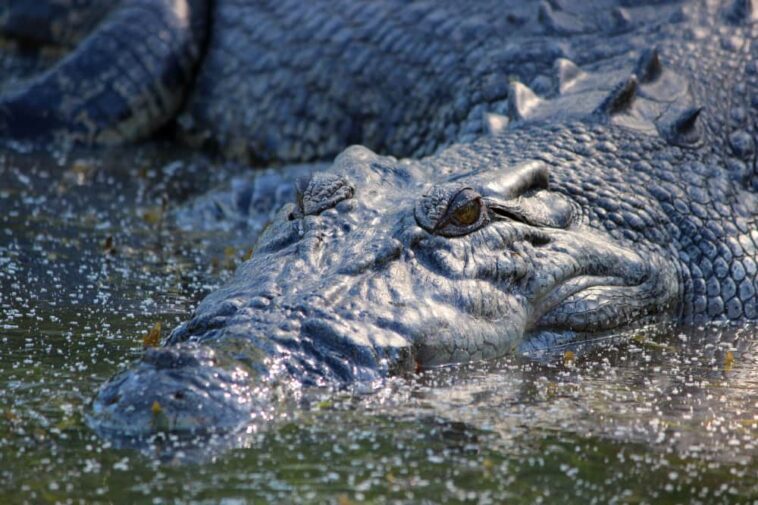Crocodile eyes are superb: Estuarine Crocodile Kakadu National Park Janine Duffy
Estimated reading time: 6 minutes
In PART TWO of our story about crocodile eyes we “look into” these superb organs that adjust instantly, in or out of water, by day or night or for near or distant vision. Attached to one of the world’s oldest and most efficient predators, can they help control feral pigs in Australia’s tropics? And is the crocodile friend or foe?
PART TWO
Fascinating facts about crocodile eyes
Eliminating 24 million pigs is a big ask for crocodiles.
Estimates on Australia’s feral pig numbers are off the charts. At roughly 24 million, pigs match the human population one to one!
Like us, pigs need food — lots of it — and to get it they root up and destroy huge areas of land and vegetation. They also carry diseases that impact on both native wildlife and farmed animals.
Can crocodiles’ superb eyes help control feral pigs?
This is a tough question to answer, but let’s give it a try using some known data and a few rough calculations. (based on how and when Estuarine Crocodiles feed the most). I’ll use these 3 measurements to figure this out:
- Numbers of feral pigs in Australia are estimated at approximately 24 million.
- It’s difficult to get estimates of the number of feral pigs in the Northern Territory but let’s go with a conservative 8 million.
- Estimates of the Estuarine Crocodile population in the Top End are as high as 100,000 adults.
If each Top End croc was to capture a wild pig every month for six months (6 x 100,000) they would take 600,000 pigs each year which is approximately 7% of my estimate of the total population. (I’ve gone with 6 months as a conservative estimate of crocodile food needs. It’s worth remembering that crocodiles, like many reptiles, have a very slow metabolism and do not require regular food — in fact they can survive without food for months during the dry season)
But that’s not the end of the story: as Professor Euan Ritchie* explains in a recent piece in The Conversation, we must allow for increases in feral pig populations through their fast breeding cycles. (Euan Ritchie: Professor in Wildlife Ecology and Conservation, School of Life & Environmental Sciences, Deakin University)
Crocodile eyes are superb: let’s celebrate that!
Crocodiles are not killers, they’re hunters. For wild animals that’s an important distinction. In human parlance killers kill out of madness, or war, or for a thrill, but animals don’t: they hunt to survive and crocodiles are experts.
Australia’s Estuarine Crocodile is the world’s largest reptile and possibly the most efficient large predator on earth. There’s no doubt that it plays a role in keeping the feral pig population in check — and it’s their superb eyesight that help them do it.
We should be inspired by them to do better to protect our country from the ravages of introduced feral animals.
Let’s celebrate that
If you’d like more incentives to celebrate crocodiles read this great Echidna Walkabout story by Janine Duffy: Crocodiles are beautiful
Ancient story behind crocodile eyes
Crocodile eyes have evolved over 200 million years and have been around 65 million years longer than most dinosaurs. In northern Australia these eyes belong to the largest living reptile in the world, Crocodylus porosus, the Estuarine OR Saltwater Crocodile*.
Crocodylus porosus is the primary hunter of wild pigs and has the most advanced eyes of any large predator on earth.
*Both common names are incorrect as these crocodiles live in both fresh and saltwater and are not only found in estuaries. In fact they have been seen hundreds of kilometres out to sea and in the headwaters of tropical rivers.
6 fascinating facts about crocodiles eyes
- Special retina
At the back of their eyes they have a special adaptation that gives them excellent vision both during the day and at night – in fact, at night the entire makeup of the retina changes to allow the equivalent of night goggle vision - Eyes on stalks
By submerging all their body they allow only their eye stalks to rise above the surface meaning that their prey have no cause to suspect a crocodile is nearby - Wide angle vision
Crocodile eyes have very wide angle vision (about 270°) which means they can see everything around them reducing head movement which may disturb their prey - Retractable eyeballs
In a fight crocodiles retract their eyeballs and protect the eye socket with a thick protective eyelid - Underwater goggles
When underwater crocodile eye structure changes entirely; a separate lens cover comes into play just like a pair of goggles. - Full colour vision
Like us, crocodiles see in full colour but their acuity is not as precise as ours. This is not a hindrance as what they lose in clarity is compensated by the fact they can track multiple targets concurrently.
References:
Astounding Facts About Crocodile Eyes : Smithsonian Institute
Spatial resolving power and spectral sensitivity of the saltwater crocodile, Crocodylus porosus, and the freshwater crocodile, Crocodylus johnstoni : Journal of Experimental Biology
Discover the wildlife of tropical Australia with Echidna Walkabout
Join our 7 day Wild Top End journey through Kakadu and Mary River National Parks. The best in-depth dedicated wildlife journey into tropical Australia. Conservation Travel with Citizen Science projects included. One departure in August each year for a maximum 0f 8 people.
Like to read a great yarn about a crocodile and a pig?
Read PART ONE: “Can crocodiles eyes help control feral pigs in Australia’s tropics?”
Find more information about the Top End – Enjoy Kakadu : 5 Best Tips
Echidna Walkabout is a Founding Member of Australian Wildlife Journeys.
We also create, guide and operate tours for Australian Geographic Travel






GIPHY App Key not set. Please check settings